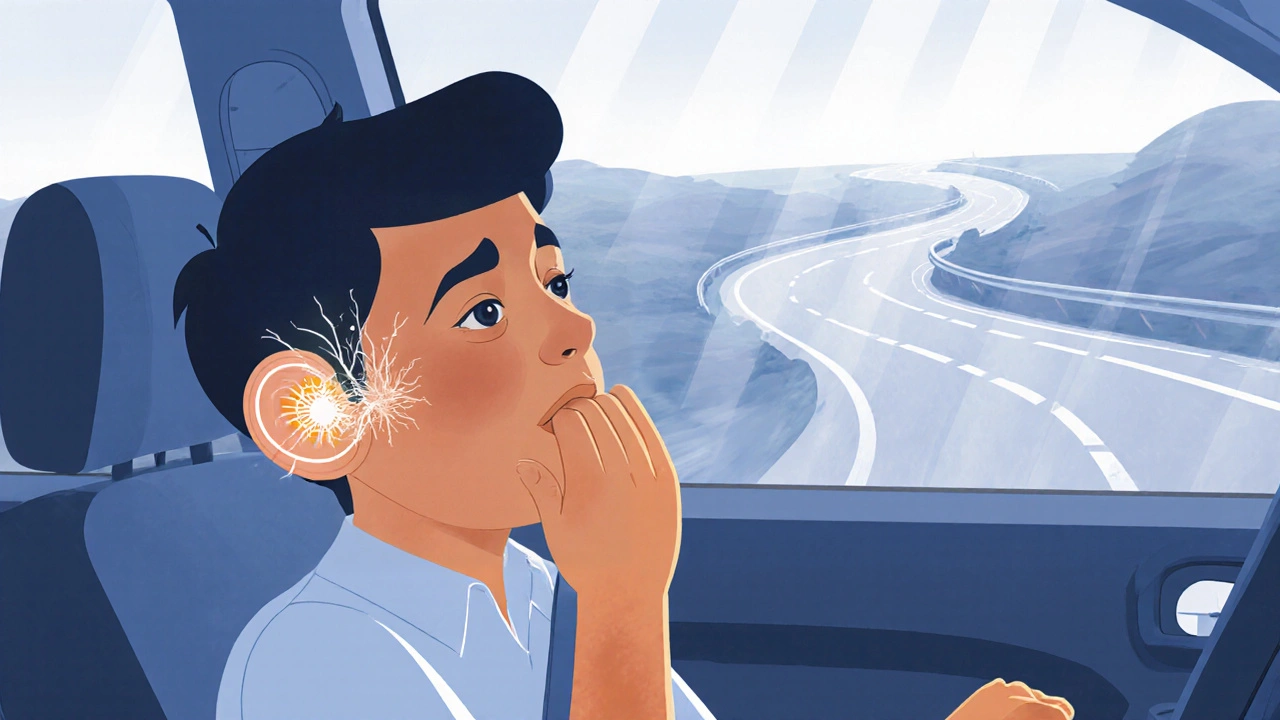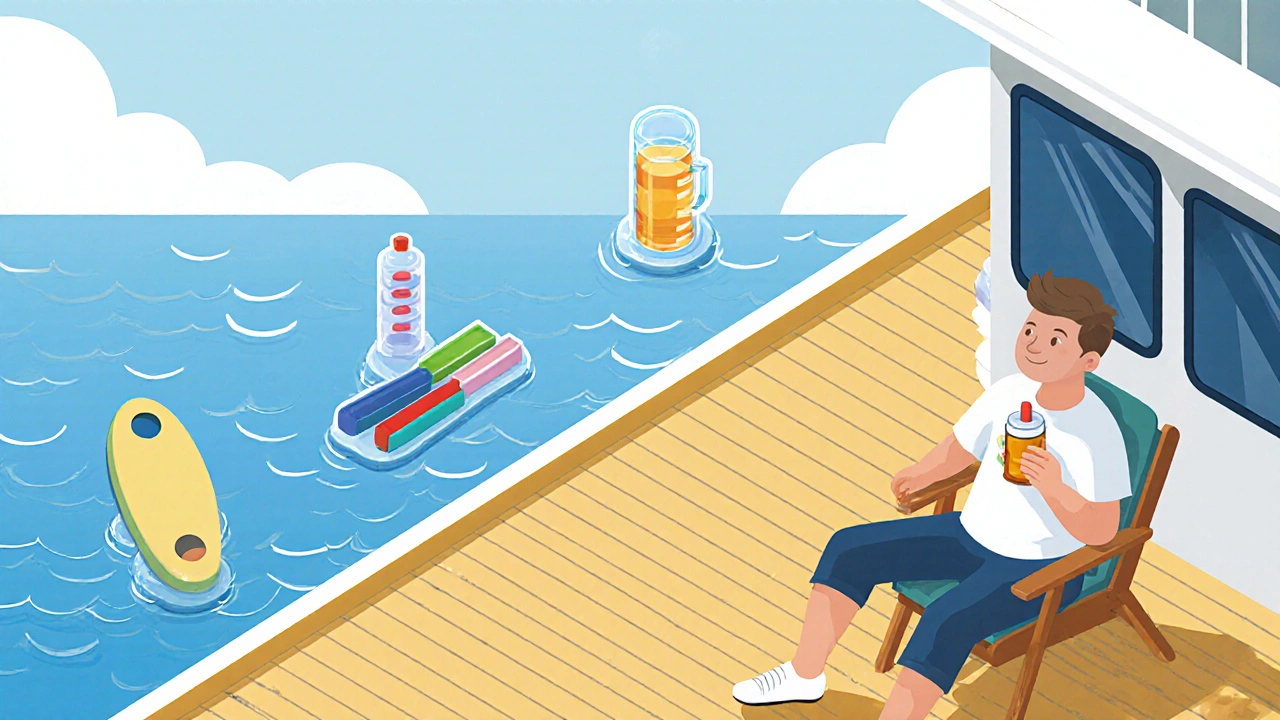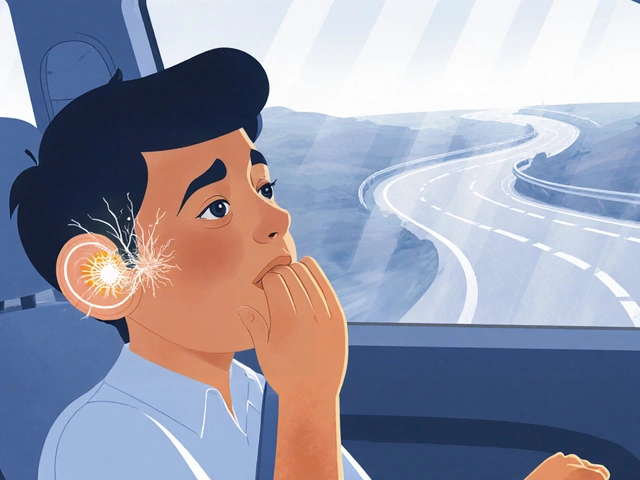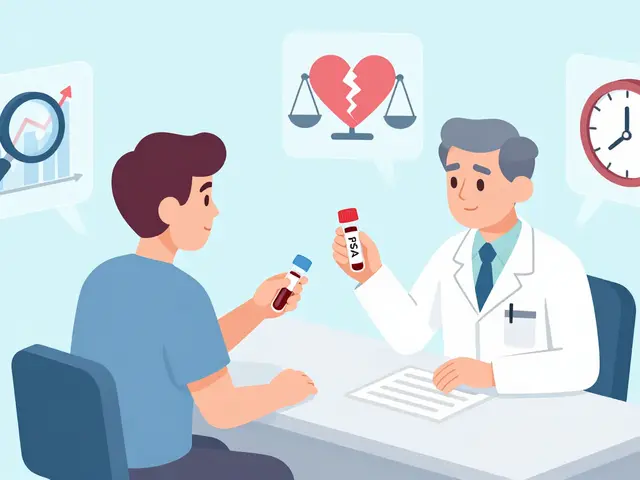How Motion Sickness Triggers Vertigo: Causes, Symptoms & Relief

Motion Sickness & Vertigo Symptom Checker
Symptom Assessment
Answer these questions to understand your risk of vertigo after motion sickness
Your Assessment
Ever felt queasy on a winding road and then woke up with that spinning sensation that makes the world feel off‑balance? That’s the link between motion sickness and vertigo. Understanding why they often appear together helps you spot the warning signs early and take steps to feel steady again.
Key Takeaways
- Motion sickness and vertigo share the same vestibular pathways, so one can spark the other.
- Conflicting sensory cues - especially visual vs. inner‑ear input - are the main trigger.
- Typical causes include car, boat, flight travel, and certain head‑position changes.
- Treatment ranges from simple lifestyle tweaks to vestibular rehabilitation and medication.
- Knowing your personal risk factors (e.g., migraine history) lets you prevent episodes before they start.
What Is Motion Sickness?
Motion Sickness is a condition where the brain receives mismatched signals about movement, leading to nausea, dizziness, and cold sweats. It usually shows up during car rides, boat trips, or even while playing VR games.
The culprit is the Vestibular System, a network of sensors in the inner ear that monitors head motion and spatial orientation. When its input conflicts with visual information, the brain reacts with a cascade of symptoms.
Defining Vertigo
Vertigo is the false sensation that you or your surroundings are spinning. Unlike general dizziness, vertigo feels like the world itself is rotating. It can be brief or last for hours, and it often stems from the same vestibular pathways that cause motion sickness.
Vertigo can arise from inner‑ear problems, neurological disorders, or even medication side effects. When it follows a bout of motion sickness, the connection is usually a lingering imbalance in the vestibular circuitry.
How the Vestibular System Bridges the Two
The vestibular system sits within the Inner Ear and includes three semicircular canals and two otolith organs. These structures detect angular and linear acceleration. Their signals travel to the Cerebellum, which fine‑tunes balance, and to the Autonomic Nervous System, which controls nausea, sweating, and heart rate.
When you look at a static interior of a car while the vehicle sways, your eyes say “still,” but the canals shout “movement.” The brain tries to reconcile the conflict, and the resulting overload produces the classic symptoms of motion sickness. If the brain can’t reset the vestibular gain quickly, the lingering mis‑signal can evolve into vertigo.
Common Triggers That Tie Them Together
- Car and Bus Travel: Repeated turns and stops create constant micro‑accelerations.
- Sea or Boat Trips: The rolling motion challenges both the otolith organs and visual reference points.
- Air Travel: Turbulence plus limited visual cues make the vestibular system work overtime.
- Virtual Reality (VR) and Gaming: Artificial visual motion without real movement confuses the brain.
- Head Position Changes: Sudden tilts can dislodge otoconia (tiny calcium crystals) - a key factor in Benign Paroxysmal Positional Vertigo (BPPV).
When Motion Sickness Leads to Vertigo
Most people recover from motion sickness once they reach their destination. However, in some cases the vestibular system stays “hyper‑active.” Here’s why:
- Prolonged Sensory Mismatch: Extended travel keeps the brain in a state of conflict, making it harder to re‑establish normal equilibrium.
- Neuro‑chemical Spillover: The autonomic nervous system releases neurotransmitters like histamine and acetylcholine to combat nausea. Excess of these chemicals can overstimulate the vestibular nuclei, prolonging dizziness.
- Underlying Conditions: People with migraine, anxiety, or prior BPPV are more likely to experience lingering vertigo after motion sickness.
Spotting the Transition: Symptoms to Watch
If you notice any of these after a motion‑sick episode, you might be entering a vertigo phase:
- Feeling the room spin even when standing still.
- Loss of balance while walking, especially in low light.
- Persistent nausea that doesn’t subside after the journey.
- Headache or pressure behind the eyes - often linked to migraine‑associated vertigo.
Early recognition lets you act before the dizziness interferes with daily tasks.
Managing Motion Sickness to Prevent Vertigo
Preventive steps focus on reducing sensory conflict and calming the autonomic response.
Before You Travel
- Choose the Right Seat: Front‑seat in cars, mid‑ship on boats, and wing seats on planes minimize motion.
- Look at the Horizon: Aligning visual cues with actual motion steadies the vestibular input.
- Stay Hydrated: Dehydration worsens nausea and dizziness.
- Take Antiemetics: Over‑the‑counter options like meclizine or dimenhydrinate work best taken 30‑60 minutes before travel.
During the Ride
- Focus on a distant, stable point.
- Avoid reading or scrolling on a phone; the eyes need stable reference.
- Practice slow, deep breathing to calm the autonomic nervous system.
- Use ginger capsules or peppermint oil - both have mild anti‑nausea properties.
After the Trip
- Rest in a quiet, dimly lit room for 10‑15 minutes.
- Gentle neck and head stretches can help reset the otolith organs.
- If vertigo symptoms linger, start a short course of vestibular rehabilitation exercises.
Targeted Treatments for Vertigo After Motion Sickness
When the spinning sensation doesn’t fade, medical options become relevant.
- Vestibular Rehabilitation Therapy (VRT): A set of balance‑training exercises designed to improve the brain’s ability to use visual and proprioceptive cues. Vestular Rehabilitation Therapy is often prescribed by physiotherapists.
- Medication: Antihistamines (meclizine), anticholinergics (scopolamine), or benzodiazepines for severe cases. Prescription should be guided by a doctor.
- Canalith Repositioning Maneuvers: For BPPV, the Epley or Semont maneuver can move displaced otoconia back into place, relieving vertigo within minutes.
- Address Underlying Migraine: If you have a history of migraine-associated vertigo, prophylactic migraine medication (beta‑blockers, topiramate) can cut down episodes.

Self‑Help Tools and Lifestyle Tweaks
Even without a doctor’s order, you can keep the vestibular system humming:
- Practice daily balance drills - standing on one foot, walking heel‑to‑toe, or using a balance board.
- Include omega‑3 rich foods (salmon, walnuts) to support neural health.
- Avoid excessive alcohol and caffeine, which can destabilize inner‑ear fluids.
- Maintain regular sleep patterns; fatigue amplifies vestibular sensitivity.
When to See a Professional
Most motion‑sick episodes are harmless, but you should seek medical advice if:
- Vertigo lasts longer than a few days.
- You experience hearing loss, ringing (tinnitus), or ear fullness.
- There are sudden, severe headaches or visual changes.
- Falls or near‑falls occur because of balance loss.
A neurologist, otolaryngologist, or vestibular physiotherapist can run tests like the Dix‑Hallpike maneuver or video‑head‑impulse testing to pinpoint the cause.
Quick Checklist for Travelers
- Pick a stable seat and keep eyes on the horizon.
- Take an anti‑nausea pill 30 minutes before departure.
- Stay hydrated and avoid heavy meals.
- Limit screen time; opt for steady visual references.
- After travel, rest, stretch, and monitor for lingering spinning.
Frequently Asked Questions
Can motion sickness cause permanent vertigo?
Usually not. Most people recover fully once the sensory conflict ends. Persistent vertigo often signals an underlying vestibular disorder that needs separate treatment.
Why does looking at the road help reduce motion sickness?
Fixing your gaze on a far, stable point aligns visual input with the motion sensed by the inner ear, reducing the brain’s sensory mismatch.
Is ginger as effective as medication for motion sickness?
Ginger offers mild relief for mild to moderate nausea and has fewer side effects, but strong antiemetics like meclizine work faster for severe cases.
What is the Epley maneuver and when should I try it?
The Epley maneuver repositions displaced otoconia in the posterior semicircular canal. If you feel brief, intense spinning after lying down, the maneuver can clear BPPV in minutes.
Can vestibular rehabilitation replace medication?
For many, regular VRT reduces dependence on drugs by strengthening the brain’s compensation mechanisms. However, acute severe vertigo may still require short‑term medication.
Understanding the shared pathways between motion sickness and vertigo lets you take smarter steps before, during, and after travel. With a mix of preventive habits, simple home remedies, and targeted therapies, you can keep both nausea and the spinning sensation at bay.






Comments (7)
jessie cole
20 Oct 2025
Understanding how motion sickness can segue into vertigo is crucial for anyone who spends time on the road or at sea. The vestibular system’s delicate balance can be thrown off by mismatched sensory signals, leading to that dreaded spinning feeling. By recognizing the early signs-nausea, sweating, and a sense that the world is tilting-you can intervene before it escalates. Simple strategies like focusing on the horizon or taking an anti‑nausea pill beforehand often make a huge difference. Stay vigilant, and you’ll keep both your stomach and your balance in check.
Vijaypal Yadav
30 Oct 2025
Motion sickness and vertigo share more than just a name; they are linked by the same vestibular circuitry. When the inner ear detects movement that your eyes do not confirm, the brain experiences a sensory mismatch. This mismatch triggers the autonomic nervous system, producing nausea, cold sweats, and a feeling of disorientation. If the mismatch persists for an extended period, the neural pathways can become sensitized, making it harder for the brain to recalibrate. Sensitization often manifests as lingering vertigo, where the world continues to feel as though it is rotating even after the motion has stopped. Studies have shown that prolonged exposure to turbulence on a plane or the rolling of a boat can increase the likelihood of this lingering effect. Additionally, chemicals released during intense nausea, such as histamine and acetylcholine, can further stimulate vestibular nuclei. People with a history of migraine or anxiety are particularly vulnerable because their nervous systems already have heightened reactivity. Preventive measures, such as sitting in the front seat of a car or mid‑ship on a vessel, help align visual cues with vestibular input. Hydration plays a pivotal role; dehydration amplifies both nausea and dizziness, creating a feedback loop that worsens symptoms. Over‑the‑counter antihistamines like meclizine work by dampening the vestibular signal, reducing the intensity of the mismatch. For those who experience vertigo after travel, vestibular rehabilitation exercises can retrain the brain to rely more on visual and proprioceptive cues. Simple head‑tilt and gaze‑stabilization drills performed daily have been shown to shorten recovery time. If vertigo persists beyond a few days, seeking a professional evaluation is advisable to rule out underlying pathologies such as BPPV or vestibular neuritis. In summary, recognizing the cascade from motion sickness to vertigo and applying both preventive and corrective strategies can keep you steady on any journey.
Rajesh Myadam
9 Nov 2025
That explanation really hits home-thanks for breaking down the science in plain terms.
Andrew Hernandez
19 Nov 2025
Pick the front seat for smoother rides
laura wood
29 Nov 2025
It’s easy to dismiss those early queasy feelings as just part of traveling, but they’re often the body’s alarm bell. When you notice that subtle nausea, reaching for a ginger capsule or a peppermint inhaler can calm the stomach before things spiral. Hydration is another underrated hero; a steady sip of water can keep the inner ear fluids balanced. After you get off the vehicle, give yourself a few minutes in a dim room and do some gentle neck rolls to help reset the vestibular system.
Kate McKay
9 Dec 2025
Great points! I’ve found that breathing slowly and focusing on a fixed point outside the car can cut the nausea in half. Sometimes I even listen to a calming playlist to keep my mind off the motion. It’s all about giving the brain consistent signals.
Demetri Huyler
20 Dec 2025
Honestly, the so‑called “modern” travel tips are just common sense that most folks ignore because they’re too busy scrolling on their phones. If you want to support American ingenuity, sit in the driver’s seat and trust the engineering of our vehicles. The vestibular system isn’t some exotic mystery; it’s a basic human sensor that respects good posture and clear sightlines.